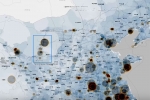Earlier this month news agencies around the world began releasing stories based on the largest leak of documents ever, the Panama Papers (https://panamapapers.icij.org/). The data visualization tool that journalists used to uncover connections between people, accounts, shell companies, and assets in this massive data set originated at the Humanities + Design (http://hdlab.stanford.edu) research lab in Stanford’s Center for Spatial and Textual Analysis (http://cesta.stanford.edu) — a product of humanities thinking applied to network analysis.
Topics
Archives
![moonlight over river Thames - John Atkinson Grimshaw, 1880 [Wikimedia Commons] moonlight over river Thames](https://swap.stanford.edu/was/20151211033644im_/http://library.stanford.edu/sites/default/files/styles/large/public/grimshaw_thames1880_adj03_0.jpg?itok=N2uv_bb3) “And place is always and only place,” writes T.S. Eliot. Is that true? Or is place rather the sum of human experience at a location—“the meeting up of histories” as geographer Doreen Massey has suggested? Does place in literature matter? The truth, usually, is simply that we don’t know. When we read a place name in a text, when we learn that a writer worked at a certain address, we read on—because how much do we know of all these places?
“And place is always and only place,” writes T.S. Eliot. Is that true? Or is place rather the sum of human experience at a location—“the meeting up of histories” as geographer Doreen Massey has suggested? Does place in literature matter? The truth, usually, is simply that we don’t know. When we read a place name in a text, when we learn that a writer worked at a certain address, we read on—because how much do we know of all these places?
A faculty-led project developed by the Stanford Libraries' Center for Interdisciplinary Digital Research (CIDR) was recently featured in Stanford Report, which describes it thus: “...a digital humanities project led by Stanford historian Tom Mullaney is creating a map that illustrates the ongoing and multifaceted impact of funeral reform and grave relocation in China. In the last 15 years, grave relocation has been taking place in China on a massive scale. To date, some 15 million deceased people's remains have been moved.” CIDR developers David McClure and Karl Grossner, together with a small SUL team, have been working on the project with Professor Mullaney over the past 18 months, and Mullaney presented a synopsis of the project at the Stanford Libraries’ annual donor event in October, 2015.
Read Stanford scholar uses digital tools to track grave relocation in China.
See also the CIDR's project page: Grave Reform in China.
Lacuna, a digital reading, writing, and annotation platform I developed, is now in use as part of a MOOC being run at Dartmouth University. An author for their EdTech blog recently wrote up the experience. Here's my favorite part of the post:
The AmRenX team is using YellowDig and Lacuna Stories to encourage engagement in Dartmouth’s first literature MOOC. YellowDig has been a different platform for some seasoned edX learners, but they have really taken to Lacuna. To date 542 learners have made 6,930 annotations in AmRenX. There is more activity in the annotation platform than any other part of the course.
For more, including animated GIFs of the platform in action, read the full post.
The Stanford University Libraries’ Center for Interdisciplinary Research (CIDR) is seeking an innovative, experienced, team-oriented software developer to build sophisticated, sustainable, and generalizable tools and infrastructure in order to support interdisciplinary digital research in the computational social sciences and digital humanities at Stanford and beyond. Regular tasks will include programming, analyzing, designing, developing, implementing, modifying, and maintaining computer programs in systems of moderate size and complexity or segments of larger systems.




 Stanford University Home
Stanford University Home